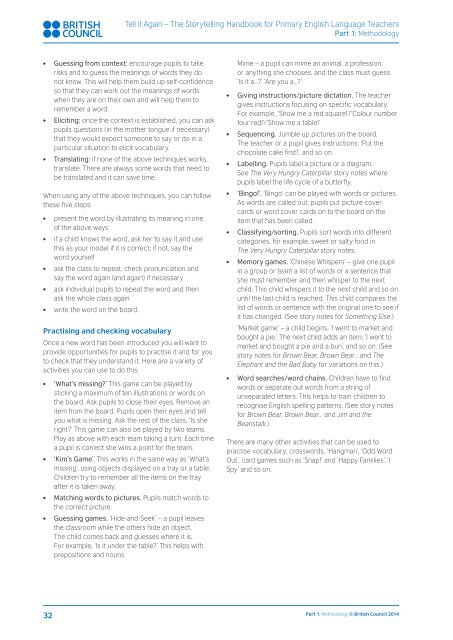1nW0gvB
1nW0gvB
1nW0gvB
You also want an ePaper? Increase the reach of your titles
YUMPU automatically turns print PDFs into web optimized ePapers that Google loves.
Tell it Again – The Storytelling Handbook for Primary English Language Teachers<br />
Part 1: Methodology<br />
●●<br />
●●<br />
●●<br />
Guessing from context: encourage pupils to take<br />
risks and to guess the meanings of words they do<br />
not know. This will help them build up self-confidence<br />
so that they can work out the meanings of words<br />
when they are on their own and will help them to<br />
remember a word.<br />
Eliciting: once the context is established, you can ask<br />
pupils questions (in the mother tongue if necessary)<br />
that they would expect someone to say or do in a<br />
particular situation to elicit vocabulary.<br />
Translating: if none of the above techniques works,<br />
translate. There are always some words that need to<br />
be translated and it can save time.<br />
When using any of the above techniques, you can follow<br />
these five steps:<br />
●●<br />
●●<br />
●●<br />
●●<br />
●●<br />
present the word by illustrating its meaning in one<br />
of the above ways<br />
if a child knows the word, ask her to say it and use<br />
this as your model if it is correct; if not, say the<br />
word yourself<br />
ask the class to repeat, check pronunciation and<br />
say the word again (and again) if necessary<br />
ask individual pupils to repeat the word and then<br />
ask the whole class again<br />
write the word on the board.<br />
Practising and checking vocabulary<br />
Once a new word has been introduced you will want to<br />
provide opportunities for pupils to practise it and for you<br />
to check that they understand it. Here are a variety of<br />
activities you can use to do this:<br />
● ●<br />
● ●<br />
●●<br />
●●<br />
‘What’s missing?’ This game can be played by<br />
sticking a maximum of ten illustrations or words on<br />
the board. Ask pupils to close their eyes. Remove an<br />
item from the board. Pupils open their eyes and tell<br />
you what is missing. Ask the rest of the class, ‘Is she<br />
right?’ This game can also be played by two teams.<br />
Play as above with each team taking a turn. Each time<br />
a pupil is correct she wins a point for the team.<br />
‘Kim’s Game’. This works in the same way as ‘What’s<br />
missing’, using objects displayed on a tray or a table.<br />
Children try to remember all the items on the tray<br />
after it is taken away.<br />
Matching words to pictures. Pupils match words to<br />
the correct picture.<br />
Guessing games. ‘Hide-and-Seek’ – a pupil leaves<br />
the classroom while the others hide an object.<br />
The child comes back and guesses where it is.<br />
For example, ‘Is it under the table?’ This helps with<br />
prepositions and nouns.<br />
●●<br />
●●<br />
●●<br />
● ●<br />
●●<br />
●●<br />
●●<br />
Mime – a pupil can mime an animal, a profession,<br />
or anything she chooses, and the class must guess:<br />
‘Is it a…?’ ‘Are you a…?’<br />
Giving instructions/picture dictation. The teacher<br />
gives instructions focusing on specific vocabulary.<br />
For example, ‘Show me a red square!’/’Colour number<br />
four red!’/’Show me a table!’<br />
Sequencing. Jumble up pictures on the board.<br />
The teacher or a pupil gives instructions: ‘Put the<br />
chocolate cake first!’, and so on.<br />
Labelling. Pupils label a picture or a diagram.<br />
See The Very Hungry Caterpillar story notes where<br />
pupils label the life cycle of a butterfly.<br />
‘Bingo!’. ‘Bingo’ can be played with words or pictures.<br />
As words are called out, pupils put picture cover<br />
cards or word cover cards on to the board on the<br />
item that has been called.<br />
Classifying/sorting. Pupils sort words into different<br />
categories, for example, sweet or salty food in<br />
The Very Hungry Caterpillar story notes.<br />
Memory games. ‘Chinese Whispers’ – give one pupil<br />
in a group or team a list of words or a sentence that<br />
she must remember and then whisper to the next<br />
child. This child whispers it to the next child and so on<br />
until the last child is reached. This child compares the<br />
list of words or sentence with the original one to see if<br />
it has changed. (See story notes for Something Else.)<br />
‘Market game’ – a child begins, ‘I went to market and<br />
bought a pie.’ The next child adds an item; ‘I went to<br />
market and bought a pie and a bun’, and so on. (See<br />
story notes for Brown Bear, Brown Bear… and The<br />
Elephant and the Bad Baby for variations on this.)<br />
Word searches/word chains. Children have to find<br />
words or separate out words from a string of<br />
unseparated letters. This helps to train children to<br />
recognise English spelling patterns. (See story notes<br />
for Brown Bear, Brown Bear… and Jim and the<br />
Beanstalk.)<br />
There are many other activities that can be used to<br />
practise vocabulary: crosswords, ‘Hangman’, ‘Odd Word<br />
Out’, card games such as ‘Snap!’ and ‘Happy Families’, ‘I<br />
Spy’ and so on.<br />
32<br />
Part 1: Methodology © British Council 2014


